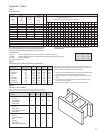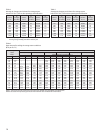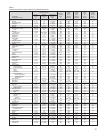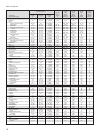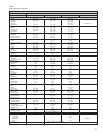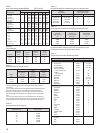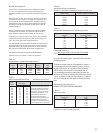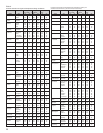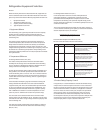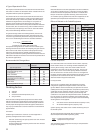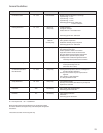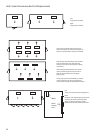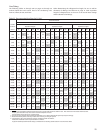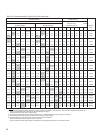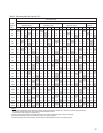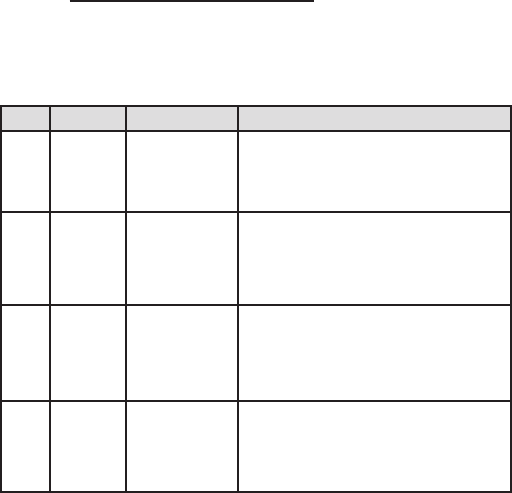
21
Refrigeration Equipment Selection
General
When the hourly BTU load has been determined, equipment can
now be selected based on the information obtained in the initial
job survey. Some of the factors aecting equipment selection are:
1. Equipment Balance
2. Temperature Dierence (T.D.)
3. Capacity Control/Product Safety
4. Type of Operation/Air Flow
1. Equipment Balance
The condensing unit is generally selected rst to have capacity
greater than the calculated cooling or freezing load. The
unit cooler(s) must be selected to balance the capacity of the
condensing unit.
The capacity of the condensing unit should be selected at a
suction temperature (after correction for suction line pressure
drop) which will balance with the unit cooler(s) at a desirable
T.D. between the refrigerant in the unit cooler and the air in the
refrigerated storage room. The condensing unit capacity must also
be selected at a condensing temperature corresponding to the
condensing medium (ambient air or water) temperature available
at the job location.
2. Temperature Dierence
For Storage Rooms Above 32ºF. (0ºC.)
The nature of the product determines the desirable relative
humidity for the storage room. The desirable relative humidity,
in turn, dictates the approximate design T.D. between the air in
storage room and the refrigerant in the unit cooler.
For the general purpose cooler involving meats, vegetables, and
dairy products, it is common procedure to balance the low side
to the condensing unit at a 10ºF. to 12ºF. T.D.. It has been learned
by experience that if this is done, one may expect to maintain in
a cooler 80% to 85% relative humidity, which is a good range for
general storage.
Load Calculation Example 2 (page 8) involved the cooling and
storage of beef. The table shows that the recommended T.D.
is approximately 10ºF. Since the calculated load per hour based
on 16 hr. of condensing unit operation was 12696 BTU/hr., the
condensing unit to be selected should have a greater capacity
than 12696 BTU/hr. based on a suction temperature of +23ºF.
(10ºF. T.D. plus 2ºF. allowance for suction line pressure drop).
The unit cooler to be selected should have a minimum base
capacity (BTU/º T.D.) of 12696/10º T.D. or 1270 BTU/º T.D./hr. to be
sure that the unit cooler is large enough to balance properly with
the condensing unit.
Low relative humidity requirements permit higher T.D. which in
turn will allow selection of unit coolers with small base ratings
(BTU/hr./º T.D.)
For Storage Rooms Below 32ºF. (0ºC.)
In low temperature rooms the amount of dehydration of
unwrapped products is proportional to the T.D. Since the
prevention of excess dehydration is important and since low
temperature condensing unit capacities drop o sharply as the
suction temperature reduced, it is considered good practice to use
a maximum T.D. of 10ºF.
T.D.’s can be approximated by dividing the unit cooler capacity at
a 1º T.D. into the condensing unit capacity at the desired saturated
suction temperature (S.S.T.) for example:
Condensing Unit Capacity at S.S.T.
= T.D.
Evaporating Capacity at 1º T.D.
Class T.D. Approx. RH Description of Product Classes
1 7º - 9ºF. 90% Results in a minimum amount of moisture
evaporation during storage. Includes
vegetables, produce, owers,
unpackaged ice and chill rooms.
2 10º - 12ºF. 80 - 85% Includes general storage & convenience
store coolers, packaged meats and
vegetables, fruits and similar products.
Products require slightly lower relative
humidity levels than those in Class I.
3 12º - 16ºF. 65 - 80% Includes beer, wine, pharmaceuticals,
potatoes and onions, tough skin fruits
such as melons & short term packaged
products. These products require only
moderate relative humidity.
4 17º - 22ºF. 50 - 65% Includes prep and cutting rooms, beer
warehouses, candy or lm storage and
loading docks. These applications need
only low relative humidities or are
unaected by humidity.
Recommended Temperature Dierences (T.D.)
for Four Classes of Foods (Forced Air Unit Coolers)
3. Product Safety/Capacity Control
In large boxes, it is recommended that the load be divided among
multiple units. A load that requires more than a 10 HP unit should
be split to provide the customer with some refrigeration level in the
event of mechanical failure. In addition, as refrigeration is selected
for the 1% worst occurrence of the year, multiple units provide for
some capacity control. In low load situations some units can be
turned o and the box maintained adequately with a fraction of
the horsepower necessary for the summer operation. Multiple units
on staged start up also cut the demand charges assessed by the
utility company which cut your customer’s electric bill.



